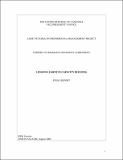| dc.description.abstract | Lake Victoria and the overall Lake Basin (LB) is an ecoregion of local, national, regional and global importance. It supports the livelihoods of one third of the populations of the riparian countries and it can be a significant moderating force to the status of a number of the Biosphere Reserves and Heritage Sites surrounding it, including the Serengeti Ecosystem. There has been little awareness on the importance of the LB and little technical knowledge on its functioning. The LVEMP1 has done a commendable job of building capacity in awareness, research, monitoring and sustainable management of the LB. Local communities, administrators, managers and decision makers have had their horizons expanded and much interest and concern over the LB has been inculcated. A number of technicians, officers and researchers have been trained at the Masters and PhD levels. The number trained varied between the eight main components of LVEMP1. It is expected that, a detailed training needs assessment that address the LB requirements first and which comes prior to allocation of training slots to individuals, institutes and components might end up building more relevant and targeted capacity even though room for basic research would still be important especially at the PhD level of training. Under LVEMP1, training was carried out without such a training needs assessment.Training at the PhD and some Masters required conducting research at the LB. This is positive since it has increased knowledge of the LB and the respective trainees have acquired knowledge in a relevant local setting thus enhancing their capability to undertake future LB assignments. It is noted that there were some minor overlaps in research topics. It is also noted that there was no clear separation between a study worth a Masters and one worth a PhD. Again, an analysis of training needs prior to undertaking the research activities would have been useful in sorting out such albeit minor anomalies A number of local and overseas institutions were used for training. While training overseas might be more efficient, it often is more expensive and it also reduces the chance for CB of local institutions especially the universities. As much as possible a project of LVEMP1 magnitude could seriously consider giving priority to local training institutions for then the equipment and tools used for the training and the experience gained through the training are left behind as potential capacity for future. Two of the ongoing PhD candidates are locally registered at Makerere and UDSM; the latter is exemplary in that he will complete both the Masters and PhD with the support of LVEMP1. They both started late (2003) into project life All who registered for Masters with UDSM completed the training in two to three year periods, and all had a research component in their training. Still the riparian universities need to address the question of efficiency and time budget. Theses and dissertations are required to be read by external examiners. Some external examiners have taken over three months to give feedbacks and it is questionable whether all the feedback given has had significant and positive impact in improving the training. In addition to formal training, there has been tremendous increase in knowledge on LB through involvement in research, conferences, seminars, meetings, field visits and local and overseas study tours that have involved all cadres from top level decision makers to data collectors at the local communities. The bulk of this capacity has a good to fair chance of involvement in future LB initiatives because the individuals involved are mostly either government employees or local residents who have now created much interest in the well being of the lake. Without these LVEMP1 inputs, such capacity would not have been realized. The LVEMP1 improved infrastructure and working gear, thus enabling the conduct of research and the other conservation activities. Offices and laboratories were built and/or renovated at both the base and field stations. Land and water travel was much facilitated through provision of cars and water vessels. Laboratory equipment and chemicals were bought and used. Prior to the LVEMP1 inputs, research and monitoring were largely stagnant and lake management highly handicapped. An exit plan could be developed that will ensure continued use and maintenance of these facilities. Several other projects and programmes have addressed the Lake region. It is noted that LVEMP1 has had the biggest impact of them all, especially in building capacity of the local people. The LVEMP1 led into a sharp increase in the number of publications by the local individuals and institutions. It enabled marked cross-sector interaction and collaboration. Without the LVEMP1 initiative, the knowledge base, to-date, would have been much less and would have continued to be dominated by overseas ad hoc efforts.A number of initiatives have taken place that impact on LB conservation but appear to have been unnoticed by the different actors. The notable example is the conservation efforts in Western Serengeti (which is actually Eastern LB) that are undertaken by the Wildlife Sector. Those involved on this seem to be unaware of the importance of the LB and the initiatives taking place at the LB. Likewise, the LB initiatives, including LVEMP1, seem to be unaware of the importance of activities taking place at the protected areas within the catchment. This gap could be bridged and the capacity on infrastructure, working gear, human resources, literature and overall work experience shared to the common good | en_US |

